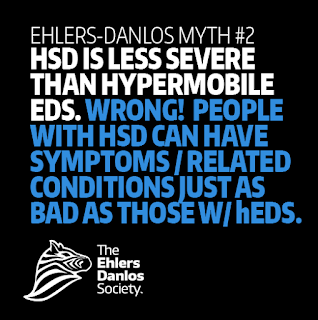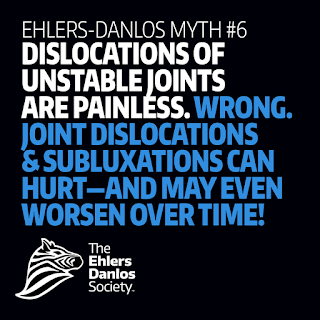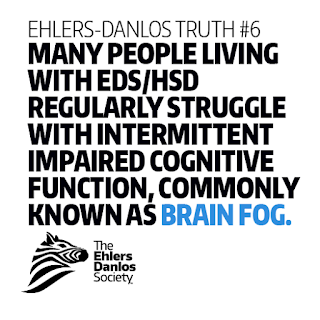I want to talk about hypermobility spectrum disorder (HSD) as there’s so much out there about Ehlers-Danlos syndrome (EDS) but little about HSD.
• What is Ehlers-Danlos Syndrome?
• What Are Common Ehlers-Danlos Syndrome Symptoms?
The zebra is the symbol for people with HSD and EDS as we are “medical zebras.” Doctors don’t automatically look for conditions like EDS or HSD, so we often go undiagnosed or are misdiagnosed.

I was originally diagnosed with joint hypermobility syndrome aka Ehlers Danlos Syndrome hypermobility type by my neurologist who referred me to an hypermobility specialist rheumatologist. My rheumatologist suspected I may have vascular EDS as well, so I was sent for genetic testing to rule out other types of EDS before giving a diagnosis of hypermobile EDS; thankfully that come back clear.
When I went back to my rheumatologist the new 2017 classification had just come in. I met many of the criteria for hEDS but I missed out on two points, so I was given the diagnosis of HSD. In the new 2017 classification they made the criteria for hEDS much stricter than before in an attempt to find the genetic marker for hEDS as all of the other 12 subtypes of EDS already have one (hence why I was sent for genetic testing for vEDS).
Hypermobility spectrum disorder is largely an invisible illness. You might see me in my wheelchair, walking with crutches or the braces and splints I wear, but you don’t see all the other symptoms and complications.

HSD is caused by faulty collagen. Collagen is the glue of the body, and because mine is faulty, it causes my joints to be lax. As a result, my joints frequently sublux or dislocate, and my organs are too stretchy so I have problems with my digestive system, heart and bladder. It’s an incredibly painful condition, and every movement exacerbates the pain because my joints are so lax. Even putting on a t-shirt or reaching for a plate can cause a a joint to sublux or dislocate! I sublux/dislocate joints multiple times a week, sometimes a day. It’s also tiring because my body is constantly trying to repair itself.
On top of that are the complications that I have secondary to my HSD. I have “delayed gastric emptying” which means my stomach empties much slower, causing me to feel constantly full, like I’ve eaten a five-course meal even though I only eat small portions. It also makes me feel nauseous all the time, sometimes leading to episodes of vomiting. I have intestinal dysmotility, so the rest of my digestive system is also sluggish and doesn’t work as well as it should, causing discomfort, cramping and bloating. On top of that, I also have IBS.
I have bladder issues. Because of my faulty collagen, my bladder is stretchy which causes it to leak. I have incontinence; it’s quite emotionally difficult to deal with and I hope my specialist can find a solution.
I have dysautonomia — my body’s automatic functions like temperature control, blood pressure, heart rate etc. doesn’t work as well leading orthostatic intolerance and POTS (postural orthostatic tachycardia syndrome).
I also have TMJ, a problem with my jaw joint. Because it’s so lax, just eating can cause it to slip out of place. Even when I’m sitting watching TV, my jaw hurts.

I want to raise more awareness of HSD as there’s lots about hEDS and EDS but little about HSD. Often HSD isn’t taken as seriously or is overlooked compared to hEDS.
HSD and my other illness all interlink, so sometimes it can be hard to work out what’s causing a symptom. My illnesses often exacerbate each other; for example, I’ll have a seizure (unrelated to my HSD) but it will cause my joints to sublux or dislocate. I live in constant pain; some days I can cope with it and the times the pain will be so immense I just want to curl up and cry.
I injure more easily, so I’m forever covered in mysterious bruises. I also have poor vein access — I have one “good” vein and if that’s gone it becomes a challenge; I’ve had needles inserted into all sorts of odd areas and often after one blood draw or medication amiss, the vein will blow and then it’s a hunt for another IV access point.
Another random symptom of HSD is that local anesthetic has no effect on me, which complicates things like going to the dentist.
Medication helps me and keeps me functioning and I’ve found physiotherapy helpful. I’m waiting to start a specialist pain management program, and once my pain is better managed I can go on a hypermobility exercise program. I’m looking forward to giving hydrotherapy a go. I also find very gentle yoga helps me stretch, but I have to be super careful not to overdo it and cause my joints to sublux/dislocate. As well as medication and physio and yoga I find heat, deep breathing and my TENS machine helps. Occupational therapy has also helped me too.
Once my seizures and other illnesses are better controlled, I hope to do an inpatient rehab program for patients with chronic pain and hypermobility disorders, but I try not to look too far ahead. I try to just take each day as it comes and deal with the challenges that present that day.
I feel very lucky to be under the expert care of specialists at UCLH who have an interest in EDS/HSD. The traveling is a pain, but it’s worth it.

A few years back I saw my local rheumatologist who told me that EDS is a condition you grow out of! That is not true at all. I firmly believe that in cases of suspected EDS/HSD patients should be referred to a specialist rheumatologist to ensure they are given the right diagnosis. It’s great that there’s now more awareness of EDS, especially hEDS, but I know firsthand how important it is to get the correct diagnosis and treatment from someone who understands.
Getty image by Larissa Zorina.

